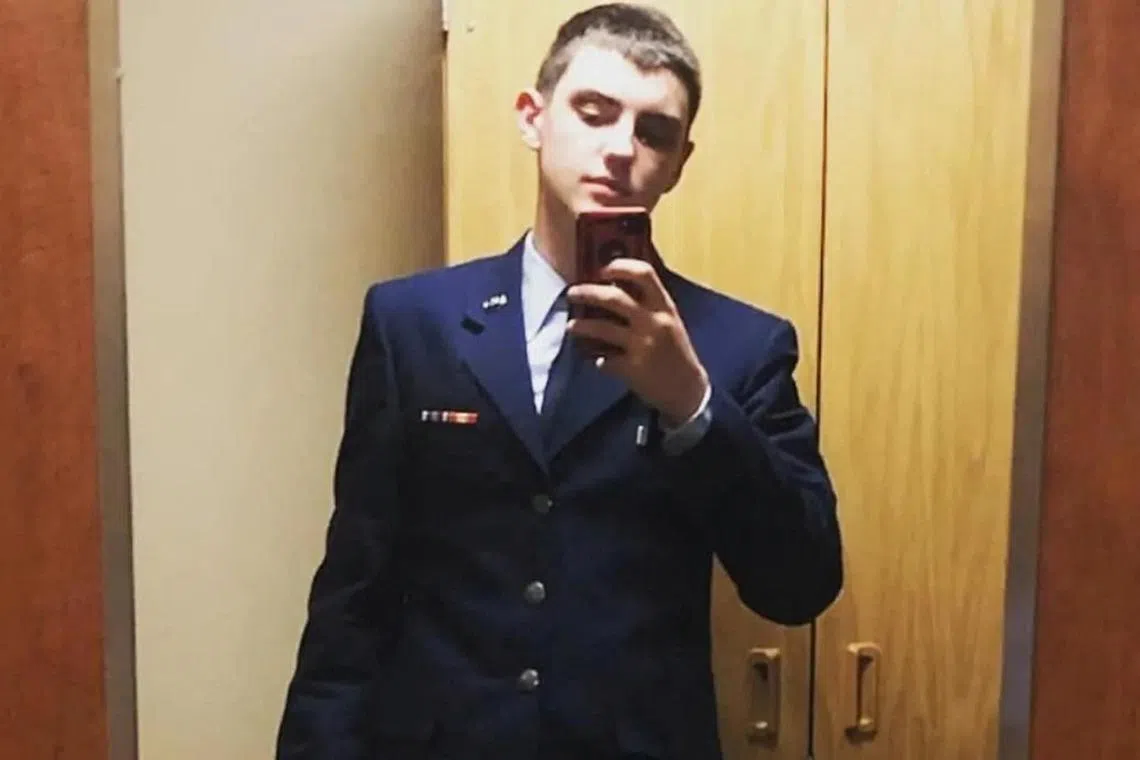US airman in leaks case worked on global network essential to drone missions
Sign up now: Get ST's newsletters delivered to your inbox

Airman 1st Class Jack Teixeira was accused of posting top-secret military reports online.
PHOTO: REUTERS
Follow topic:
WASHINGTON – On an Air National Guard base in Cape Cod, Massachusetts, more than 1,200 military service members and civilians maintain one of the largest support systems for Pentagon drone missions around the world.
One of the workers was Airman 1st Class Jack Teixeira, the 21-year-old accused of posting top-secret military reports online.
Why such a young, junior-ranking service member on Cape Cod had access to sensitive intelligence, including battlefield updates on the war in Ukraine, has to do with the vast expansion in military drone operations in the post-9/11 wars that was made possible by better satellite communication networks.
It is also the result of a drastic reorganisation in the Air National Guard that left small, far-flung air bases in need of new responsibilities. The one on Cape Cod and many others became intelligence outfits.
His arrest and subsequent Justice Department disclosures shone a light on a little-known Air Force mission that began in the 1990s and grew rapidly, eventually spreading to the base on Cape Cod.
Called the Distributed Common Ground System, it is a vast computer network that handles the immense amounts of data generated by surveillance drones, spy satellites and other sensors – information that intelligence analysts pore through and pass along to troops on the ground.
Usually referred to as DCGS, it carries top-secret information, and working on it requires an equivalent security clearance.
The system is now a worldwide network.
But according to the Air Force, it started small at just three Air Force bases – Langley in Virginia, Beale in California and Osan in South Korea.
It expanded in the early 2000s as the US military placed more communication satellites in space and demand for airborne surveillance surged.
In 2001, according to Pentagon leadership, the US military had about 200 drones in service. In the years that followed, commanders in Afghanistan and later in Iraq wanted more of them. Many more.
The network soon expanded to two more bases: Ramstein, in Germany, in early 2003 and Hickam, in Honolulu, in late 2004, Air Force documents say.
According to two retired Air Force intelligence officers with direct experience in the system, a key decision by Congress at that time freed up a large labour pool to serve at new sites.
In 2005, the Pentagon’s Base Realignment and Closure commission made recommendations that affected most of the Air National Guard’s aviation units, with 14 of them losing their flying mission, the Government Accountability Office reported.
The move left thousands of air guardsmen without jobs, the officers said, speaking on the condition of anonymity because of their continuing work for companies that do business with the federal government.
One of those units was the 102nd Fighter Wing at a base called Otis on Cape Cod.
Men and women from that Air National Guard wing and other former flying units began training to work on the DCGS.
They learnt to run its computers and analyse intelligence from spy planes and the ever-increasing numbers of drones flying in combat missions overseas, the retired officers said.
In a speech to the Air War College in 2008, Mr Robert Gates, then the secretary of defence, said the number of unmanned aircraft in service with the US military had increased to more than 5,000.
Stations for the network were soon established at Air National Guard bases in Indiana and at Otis, where Teixeira’s stepfather made the transition from the 102nd Fighter Wing to a post at the newly christened 102nd Intelligence Wing.
Today, there are 27 DCGS stations in the United States and two foreign countries, according to Air Force documents.
But the original five are the busiest, operating non-stop year-round, the retired officers said. Each of those sites is supported by a corresponding Air National Guard unit.
The unit in Germany is currently in great demand because it serves the US European Command, and, by extension, America’s support of Ukraine in its war with Russia.
The Ramstein station is backed up by the 102nd Intelligence Wing at Joint Base Cape Cod, the officers said, which is supported by the 102nd Intelligence Support Squadron, where Teixeira is stationed.
By 2019, when Teixeira joined the Air National Guard, the US military was operating more than 11,000 drones, according to the Pentagon.
In 2021, his top-secret clearance was approved, Justice Department charging documents said.
This allowed him entry into the facility, which has an operations floor filled with computer terminals and flat-screen televisions showing live video feeds from classified drone missions.
Some sites have operations facilities many thousands of square feet in size, the officers said. Cellphones are not allowed inside.
How the intelligence reports were allegedly removed from secure spaces remains unclear.
President Joe Biden has instructed officials to get to the root of why Teixeira “had access in the first place”, and Pentagon leaders are reviewing how intelligence is shared and who will have access to certain reports in the future.
The Air Force announced on April 18 it had temporarily shut down the 102nd Intelligence Wing’s missions, which have been transferred to “other organisations” in the service.
In the most recent fallout, two of Teixeira’s superiors at the wing have been suspended
Their access to classified information has been temporarily blocked, a spokesperson added. NYTIMES

